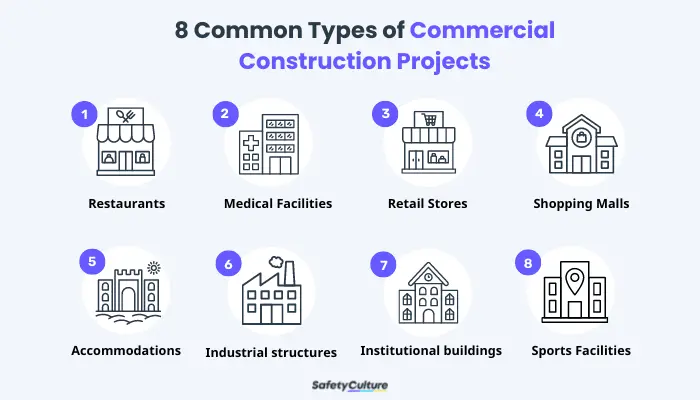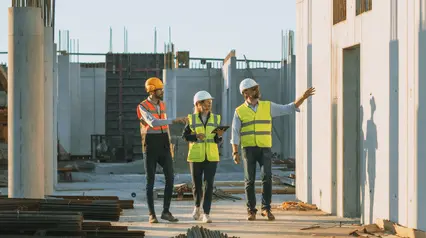What is Commercial Construction?
Commercial construction involves the construction of buildings and other structures used for commercial purposes. It includes office buildings, retail stores, warehouses, factories, and more. In commercial construction, various professionals are involved, from architects to engineers to contractors. The first step in commercial construction is usually to develop a plan for the project that will consider the client’s specific needs, the site’s size and location, and any regulatory requirements. Once the plan is complete, the construction team can begin working on erecting the actual structure. This entire process requires excellent coordination, collaboration, and a significant amount of resources. When finished, commercial construction projects can provide valuable space for businesses to operate.
How is Commercial Construction Different From Residential Construction?
Although commercial and residential construction is under the private construction umbrella, there are key differences regarding financing, site size, and equipment requirements. Below are the key differentiators between commercial and residential construction:
Commercial Construction
- Projects are generally larger in scale than residential construction projects.
- Private investment and loans typically fund commercial construction projects.
- The construction site is typically more extensive than a residential construction site.
- Commercial construction projects often require specialized equipment not commonly used in residential construction.
Residential Construction
- Private investment and mortgages typically fund residential construction projects.
- The construction site is usually smaller than a commercial construction site.
- Residential construction projects usually don’t require specialized equipment.
8 Common Types of Commercial Construction Projects
Commercial construction involves a wide range of projects. The following are some of the most frequent commercial construction tasks.

8 Common Types of Commercial Construction Projects | SafetyCulture
- Restaurants
- Medical Facilities
- Retail & Grocery Stores
- Shopping Malls
- Accommodations such as hotels, apartments, etc.
- Industrial structures such as factories, warehouses
- Institutional buildings such as high schools, universities
- Sports Facilities
Levels of Commercial Construction
Construction projects for businesses can vary, from small examples like family restaurants to mid-size office structures and large high-rises found in metropolitan areas.
Small-Scale Construction Projects
Generally, small-scale construction involves renovations, repairs, or expansions that don’t significantly alter a building’s footprint. Typically, these projects take less time to complete than mid-size or large-scale construction and require less equipment and crew members.
Examples
- Installing new windows, doors, or roofs
- Interior office renovations or remodelling
- HVAC system upgrade or installation
Mid-Scale Construction Projects
Medium-scale construction entails upgrading, expanding, and starting from the ground up. Projects are more complex than small-scale projects, such as adding a floor to a building. It implies that projects might need several months or even a year to complete.
Examples
- Buildings for businesses like mid-size offices, hotels, or medical facilities
- Construction of a new wing for an existing structure
Large-Scale Construction Projects
Large-scale construction is any project that significantly changes the footprint of a building or creates an entirely new structure. These jobs are much more complex than small or mid-size projects, often taking years to finish. Not only do they take longer, but they also require more specialized equipment and a high level of coordination among various teams.
Examples
- Buildings for businesses like large offices, skyscrapers, or shopping malls
- Infrastructure projects like airports or bridges
How to Complete a Commercial Building Construction Project
Successful commercial building construction requires several steps. Below is a high-level breakdown of the process:
Step 1: The Development and Planning Phase
This stage begins before a project is authorized and any planning begins. The initial design stage usually takes three distinct steps:
- Programming and Feasibility – The planning team describes the project’s objectives and goals through a feasibility study or business case. This step determines the size of the building, how much space it will need, and how many rooms it will require. A Project Inception Document (PID) outlines these decisions.
- Schematic Design – The team then produces a sketch showcasing the space, materials, colors, and textures. This data will be used during the design development to research any necessary equipment or materials.
- Contract Documents –The final drawings and specifications are all found in these files. Bidders use these documents to collaborate on the job.
Common Challenges
Miscommunication is the most significant barrier to getting a project on the right foot. To craft the appropriate design, project managers must stay in touch with the client, designer, architect, suppliers, and engineers. Without a dependable communication channel, this is virtually impossible.
The lack of clear objectives is another major issue at the start of commercial construction project management. Sometimes, project stakeholders are unaware of precisely what they want or cannot agree on materials. It’s tough to handle a project if the goals aren’t apparent.
Step 2: The Pre-Construction Phase
Once the bidding process is over, a contractor is selected to begin the construction process. It is necessary to form a project team before ‘breaking ground,’ as the industry says. A typical unit consists of the following members:
- Project Manager
- Contract Administrator
- Field Engineer
- Superintendent
- Health and Safety Manager
The project team’s next task is to read the construction site before any work begins. It might involve taking care of environmental issues, such as soil testing. The city authorities will review all construction plans and findings after the site inspection.
After finalizing the strategic plan and budget, the project team begins gathering labor and resources. It includes designers, architects, engineers, and other professionals needed to bring the project to fruition.
Common Challenges
Many variables may go unnoticed when there’s no clear picture of what the project will look like, the process involved, or the completion date. Insufficient planning ahead of time may lead to false expectations on the client’s part. When the project is in progress, inadequate preparation raises the danger of problems and hinders risk management.
There are several legal issues, permits, and building codes to consider during the pre-construction phase. Without careful documentation management, documentation storage and control may become another issue.
Step 3: The Procurement Phase
This phase involves ordering, purchasing, or renting materials, tools, and services. This stage of construction can pose more or fewer challenges depending on the project’s scope, resources available, and start date.
Common Challenges
Clear communication is key to success in this phase. Without it, the client might not have defined their expectations well, the contractor could face shipping delays or receive the wrong product, and project managers might find themselves in a bind. Whether it’s a small project like redecorating a living room or something much grander, such as constructing a new golf club, the project is at risk if the information isn’t transparent and complete.
If your staff cannot communicate effectively about purchasing and inventory management, they may overspend, double-buy, or purchase items unnecessary for the project. It can lead to even more expensive replacement costs and wasted time.
Step 4: The Construction Phase
All the effort you and your team put in during the planning stages will pay off now. Before any construction begins, the project manager, design, and engineering teams have already worked hard to set the project up for success. During construction, control falls to contractors and subcontractors.
The construction manager and contractor will take the project from inception to completion as the communications center. Quality control inspections, Requests for Information (RFIs), and technical submittals are all evaluated and approved by the architect, engineers, and project manager. The contractor should complete the project on time.
Common Challenges
Construction should go well if the project team has fully and correctly completed the planning and pre-construction phases. Even with adequate preparation, however, there are obstacles. Mislabeled scheduling is a significant problem for the Construction Phase.
Unfortunately, poor scheduling is too common at this stage in the game. It happens because most physical construction takes place linearly – meaning one construction team can’t move forward with their part of the project until another team finishes theirs. And to make matters worse, each worker usually has their schedule. A lack of coordination leaves busy crew members guessing what to do each day. Bad planning and scheduling inevitably lead to delays and costly budget overruns down the line.
In this stage, you may have difficulties with communication or missing data. Several things can go wrong during the construction process. For example, invoices or inventory lists might go missing, design modifications or blueprints might not get to everyone who needs them, and there might be delays. The right software can solve all of these problems.
Digitize the way you Work
Empower your team with SafetyCulture to perform checks, train staff, report issues, and automate tasks with our digital platform.
Get Started for FreeStep 5: The Post-Construction Phase
Following the completion of construction at the job site, the project closure phase will begin. A project closeout entails more than simply finishing the punch list. Deactivating assets, returning equipment rentals, cleaning up the worksite, and allowing subcontractors to head elsewhere are all essential steps before moving on to the next project.
A post-project review is beneficial to detect incomplete tasks, analyze struggles and consolidate a list of pointers for the future. It’s helpful from a project management perspective.
Common Challenges
When the closeout is complete, it is time to clear all equipment and personnel. This phase is crucial since it allows you to avoid costly delays by managing everything effectively.
Getting all the required documentation for a construction project to the owner is one of the final responsibilities of the project management team. Paper-based document management can lead to various documentation problems and gaps, so using software to manage this process is critical for success.
FAQs about Commercial Construction
It is common to use the terms commercial and industrial interchangeably, but they are different. Commercial construction includes office buildings, retail stores, restaurants, and hotels. Industrial construction, on the other hand, covers projects such as factories, power plants, and chemical plants.
Any building project built for business purposes falls under the commercial construction category. It can include office buildings, retail stores, restaurants, and hotels.
There are four types of buildings: residential, commercial, industrial, and infrastructure.
- Residential construction includes single-family homes, multi-family homes, and apartments.
- Commercial construction includes office buildings, retail stores, restaurants, and hotels.
- Industrial construction includes factories, power plants, and chemical plants.
- Infrastructure construction includes tunnels, bridges, roads, and railways.
The contractor is under contract with the client for the construction project, including all work done by subcontractors. On the other hand, there are various ways to hire subcontractors, such as task-based with no set deadline, long-term contracts with no expiration date, and fixed-term contracts.




